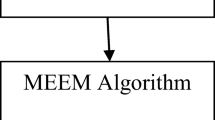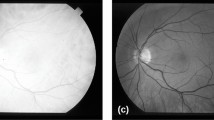Abstract
The aim was to present a novel automated approach for extracting the vasculature of retinal fundus images. The proposed vasculature extraction method on retinal fundus images consists of two phases: preprocessing phase and segmentation phase. In the first phase, brightness enhancement is applied for the retinal fundus images. For the vessel segmentation phase, a hybrid model of multilevel thresholding along with whale optimization algorithm (WOA) is performed. WOA is used to improve the segmentation accuracy through finding the \(n{-}1\) optimal n-level threshold on the fundus image. To evaluate the accuracy, sensitivity, specificity, accuracy, receiver operating characteristic (ROC) curve analysis measurements are used. The proposed approach achieved an overall accuracy of 97.8%, sensitivity of 88.9%, and specificity of 98.7% for the identification of retinal blood vessels by using a dataset that was collected from Bostan diagnostic center in Fayoum city. The area under the ROC curve reached a value of 0.967. Automated identification of retinal blood vessels based on whale algorithm seems highly successful through a comprehensive optimization process of operational parameters.




Similar content being viewed by others
References
Ahmed, M.I., Amin, M.A.: High speed detection of optical disc in retinal fundus image. Signal Image Video Process. 9(1), 77–85 (2015)
Binkley, K.J., Hagiwara, M.: Balancing exploitation and exploration in particle swarm optimization: velocity-based reinitialization. Trans. Jpn. Soc. Artif. Intell. 23(1), 27–35 (2008)
Bose, A., Mali, K.: Fuzzy-based artificial bee colony optimization for gray image segmentation. Signal Image Video Process. 10(6), 1–8 (2016)
Cortinovis, D., Srl, O.: Retina blood vessel segmentation with a convolution neural network (u-net). https://github.com/orobix/retina-unet (2016). Online; Accessed 22 Mar 2017
Fraz, M.M., Barman, S.A., Remagnino, P., Hoppe, A., Basit, A., Uyyanonvara, B., Rudnicka, A.R., Owen, C.G.: An approach to localize the retinal blood vessels using bit planes and centerline detection. Comput. Methods Programs Biomed. 108(2), 600–616 (2012)
Hassan, G., El-Bendary, N., Hassanien, A.E., Fahmy, A.: Blood vessel segmentation approach for extracting the vasculature on retinal fundus images using particle swarm optimization. In: 2015 11th international computer engineering conference (ICENCO), pp. 290–296. IEEE (2015)
Hassan, G., El-Bendary, N., Hassanien, A.E., Fahmy, A., Snasel, V., Shoeb, A.: Retinal blood vessel segmentation approach based on mathematical morphology. Procedia Comput. Sci. 65, 612–622 (2015)
Kulkarni, R.V., Venayagamoorthy, G.K.: Bio-inspired algorithms for autonomous deployment and localization of sensor nodes. IEEE Trans. Syst. Man Cybern. Part C (Appl. Rev.) 40(6), 663–675 (2010)
Liskowski, P., Krawiec, K.: Segmenting retinal blood vessels with deep neural networks. IEEE Trans. Med. Imaging 35(11), 2369–2380 (2016)
Melinščak, M., Prentašić, P., Lončarić, S.: Retinal vessel segmentation using deep neural networks. In: VISAPP 2015 (10th international conference on computer vision theory and applications), pp. 755–582 (2015)
Mirjalili, S., Lewis, A.: The whale optimization algorithm. Adv. Eng. Softw. 95, 51–67 (2016)
Nazari, P., Pourghassem, H.: An automated vessel segmentation algorithm in retinal images using 2D Gabor wavelet. In: 8th Iranian conference on machine vision and image processing (MVIP), 2013 pp. 145–149. IEEE (2013)
Niemeijer, J.J., Staal, B.V., Ginneken, M., Loog, M.D., Abramoff, M.D.: DRIVE: Digital Retinal Images for Vessel Extraction. http://www.isi.uu.nl/Research/Databases/DRIVE (2004). Online; Accessed 6 Jan 2015
Roychowdhury, S., Koozekanani, D.D., Parhi, K.K.: Blood vessel segmentation of fundus images by major vessel extraction and subimage classification. IEEE J. Biomed. Health Inf. 19(3), 1118–1128 (2015)
Roychowdhury, S., Koozekanani, D.D., Parhi, K.K.: Iterative vessel segmentation of fundus images. IEEE Trans. Biomed. Eng. 62(7), 1738–1749 (2015)
Tsai, D.M.: A fast thresholding selection procedure for multimodal and unimodal histograms. Pattern Recognit. Lett. 16(6), 653–666 (1995)
Author information
Authors and Affiliations
Corresponding author
Additional information
Scientific Research Group in Egypt http://www.egyptscience.net.
Rights and permissions
About this article
Cite this article
Hassan, G., Hassanien, A.E. Retinal fundus vasculature multilevel segmentation using whale optimization algorithm. SIViP 12, 263–270 (2018). https://doi.org/10.1007/s11760-017-1154-z
Received:
Revised:
Accepted:
Published:
Issue Date:
DOI: https://doi.org/10.1007/s11760-017-1154-z




